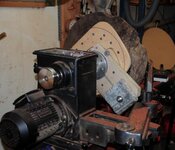I have to agree totally with Frank. When my Powermatic headstock is secured to the bed, nothing on heaven or earth can make it rattle against the bed. It's virtually "welded" to the bed. There is zero chance of rattling, unless of course something in the cam system is broken. Then it will be painfully obvious, as eventually it will fall off on your foot. It weighs nearly 200 pounds. When it hits your foot you will feel it. Then, you'll have a positive answer as to what was making that rattle. But that is NOT part of the sliding headstock design. I've put huge, unbalanced stock on this lathe (natural edged stuff CAN'T be balanced, except with blind luck), and using the basics of correct speed (although that can't be stressed enough to new turners) and common sense I've never had a lick of rattling. That's not to say Powermatics or ANY lathe are immune to bearings failing at some point. But my original premise holds, IMHO.
Weight is good. And not just in the legs, but in the bed, and the headstock.
Greg, I must say that is one interesting looking contraption you've come up with for balancing stock! I guess my first concern would be if the nut holding that weight ever slipped, but I'm quite sure you've wrung that out already. Very interesting indeed. You should market that, and with any luck, like Paul Huffman, you'll never have time to turn again!!!
Dale

